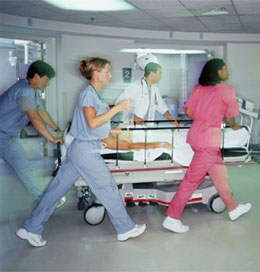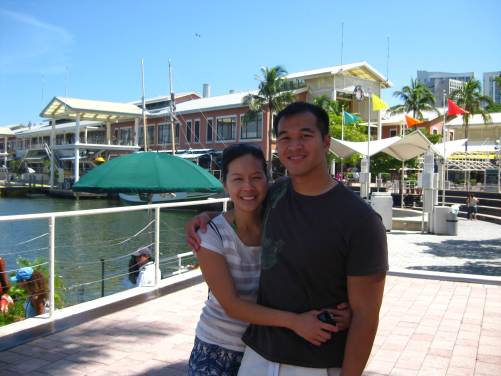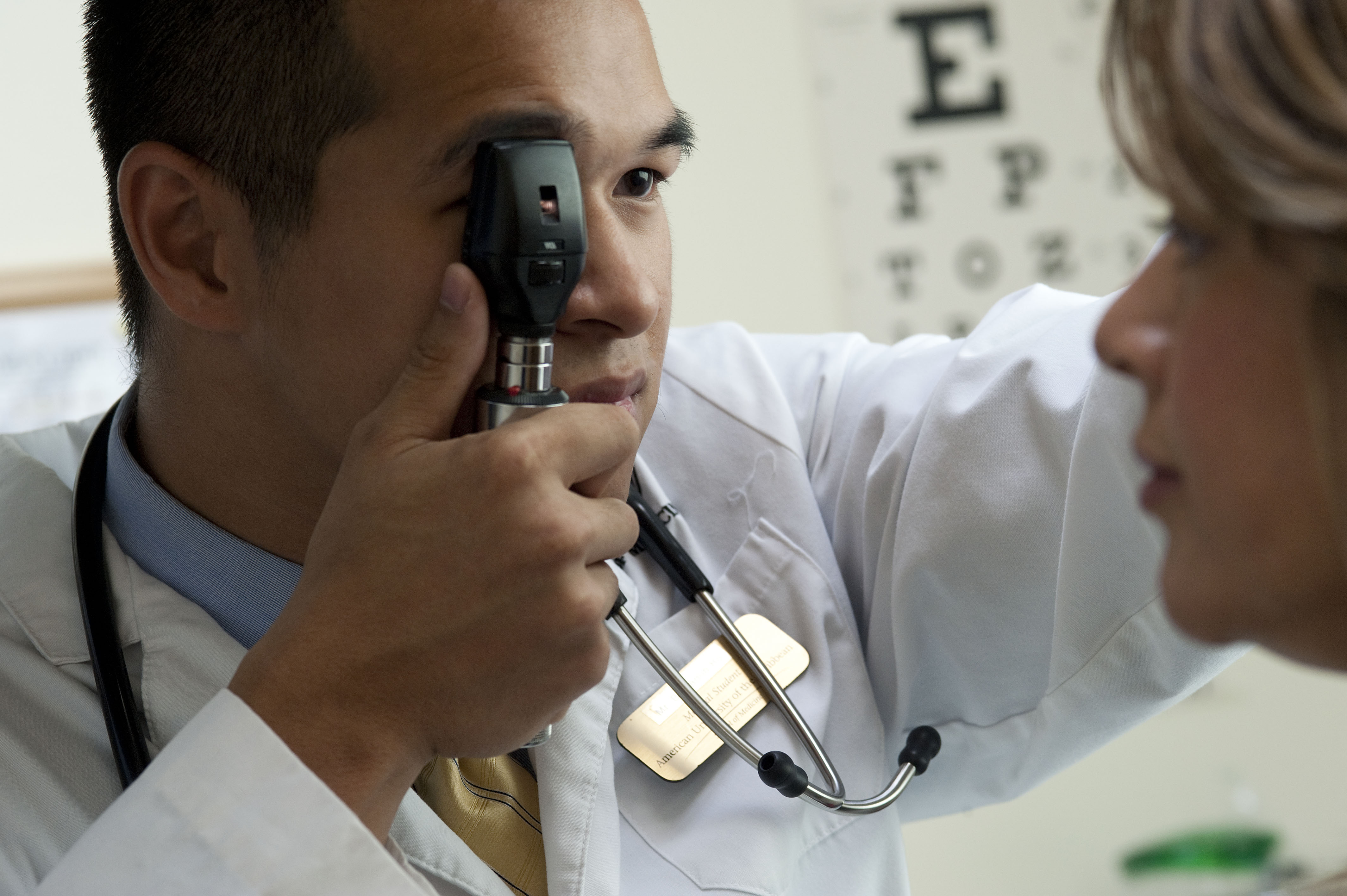Internal Medicine Rotation in Miami

Hi everyone! I have just completed my first two weeks of my internal medicine rotation, with ten more weeks to go, and already, I’ve seen quite some interesting cases. I had the opportunity to see patients with enterocutaneous fistula, respiratory failure, COPD, crush injuries, hematemesis, among many. As my current attending is also in charge of the hyperbaric chambers here at the hospital, I saw and learned about hyperbaric medicine as well. The field of internal medicine is extremely broad and there’s quite a lot to see, look up, ask, and learn. The vast amount of knowledge that is required to master this field is definitely challenging, and as my attending says, “one must learn how to crawl, walk, then run.” I am definitely still learning how to crawl at this point. Nevertheless I’m enjoying it, and taking advantage of this opportunity in the hospital to learn.
For those of you interested, I’ve put together some information about the Internal Medicine rotation for AUC here in Miami.
How is the Internal Medicine rotation in Miami organised?
Internal Medicine core rotation is 12 weeks (or three months) total. In Miami, you rotate with a different attending physician every two weeks. They schedule you to have one month of inpatient experience, one month of outpatient, and one month that is a toss up between the two of your choice. Rotations are every weekday. In addition to rotations, we also have mandatory lectures once a week, as well as mandatory ER shifts 3 times a month.
Who do you rotate with?
Unlike many other teaching hospitals in the US where students may work under residents and hardly see their attending physicians, here in Miami, students directly rotate with their attending physicians. While other hospitals may assign as many as 10 students per attending, here in Miami, we rotate at most with only one or two other AUC students. Because of this low student-to-faculty ratio, I feel we get a lot more personalized attention and have a closer working relationship with the doctors here than many other places.
What is an ER Shift?
In addition to our normal internal medicine rotations with our attending physicians, MBCHC also assigns us mandatory Emergency Room Shifts three times a month. These can happen any day of the week (including weekends), and the shifts are often 10-12 hours long. If our ER shift happens to conflict with our regular rotation schedule or lecture, then our ER shift takes precedence and we attend our ER shift. We do not have to make up for the regular rotation or lecture that we missed because of our ER shift. The ER shifts are really exciting and you see all sorts of acute cases, and it takes place at Hialeah Hospital, in the emergency department. Wear your scrubs, white coat, and stethoscope.
What are the mandatory weekly lectures like?
The lectures take place every Wednesday evening (6-7pm for us), and they are mandatory. These lectures cover a variety of medical topics that are part of the clinical syllabus for AUC. Lecture topics include diabetes, preventative medicine, hypertension, acute coronary syndrome, chest pain, thyroid disease, back pain, knee pain, arthritis, dyspnea/asthma/COPD, HIV, EKG, osteoporosis, arrythmias, and obesity. The lectures are attended by both students from AUC and Ross University who are rotating in Internal Medicine in Miami. The lectures are given by a variety of doctors, and are usually very interactive, with the lecturers provoking discussion among the students. The lectures are accompanied by case studies and readings that are posted online on MBCHC’s learning media platform website. Students are encouraged to participate (and they do participate) in the online discussion of the cases. If you want to get a letter of recommendation from the program director, one of the things he may look at is how much you contribute to the online discussion of the cases. It’s beneficial to both your education and reputation to actively participate.
Are there any assignments that we turn in?
We are required to write a SOAP note every week during our rotation. Each attending you rotate with may have their own particular way to do a SOAP note. In that case, follow the format that they prefer, and write it on a patient that you saw. Have your attending sign the SOAP note and hand it into the MBCHC Internal Medicine Rotation Coordinator. Make sure to omit or mark out any names, or other sources of identity that may violate HIPAA’s patient confidentiality guidelines. Like all other rotations at AUC, you will also be required to document your cases on AUC’s case logs sheet, at least one or two for each day of your rotation. Have your attending sign your case logs, and email or mail the document to AUC’s clinical office at the end of your rotation. In addition, each attending physician may have you do presentations, reports, or other assignments.
How are we graded?
Besides the SOAP notes and case logs that you turn in, you will also need to give your attending an evaluation form from AUC in which he or she will evaluate your performance during your rotation. Since in internal medicine rotation you rotate with a different doctor every two weeks, you will have rotated with 6 doctors by the end of your 12 week rotation, along with the doctors from your ER shifts. You are required to get evaluations from at least three of these doctors (and at most 5). One of the evaluations must be from an in-patient doctor, one must be from an out-patient doctor, and one must be from your ER shift. Your final evaluation is then calculated from averaging these individual evaluations. In addition to the evaluation, you must also pass the NBME Internal Medicine shelf exam. Most people usually take the exam on the last Friday of the rotation. You can schedule the exam via the AUC Office of Clinical Student Affairs (OCSA).
What is the dress code?
For guys, nice pants, button-up shirt, tie, nice shoes, white coat. For girls, business professional + white coat. No scrubs. They prefer us to wear a blank white coat with no logo, although they will not stop you if you wear your AUC white coat. Just make sure the white coat is a SHORT white coat! You will also be required to wear the ID of the hospital you are rotating that day, and then return your ID when you are finished with the rotation.
What else should I bring on rotations?
As you’ll be examining a lot of patients, I’d recommend carrying your own stethoscope (which is required) and pen light with you. I’d also suggest carrying a pen and notepad for you to take notes on the patients you’ve seen, as well as some sort of reference book in case you need to look up something. The most popular pocket manual I’ve seen students carry is either The Massachusetts General Hospital Handbook of Internal Medicine or Oxford American Handbook of Clinical Medicine
. I’d recommend the Oxford one because it’s easier to navigate through. Another book that may be helpful is Tarascon Pocket Pharmacopoeia 2012
, which is a great reference if you want to look up drugs.
If you wear a white coat with lots of pockets, you should be able to fit all of these items in your pockets. If you don’t want to carry around all this stuff and you have an iPhone, you could always just download pocket manuals and drug reference guides onto your phone instead of carrying around physical books. If you have an iPhone, you can also download a flashlight app and use that instead of a penlight when examining the patients pupillary reflexes.
Which hospitals do we rotate in?
Although our school’s affiliation is with Miami Beach Community Health Center (MBCHC), students actually may rotate with any one of MBCHC’s affiliated hospitals and clinics. Therefore, students here may rotate at MBCHC, Mt. Sinai Hospital, University of Miami Hospital (UMH), Jackson Memorial Hospital, or outpatient clinics of doctors affiliated with MBCHC. Because hospitals like Mt. Sinai, UMH, and Jackson are large teaching hospitals, we get to see quite a variety of interesting cases.
When would I know which hospital and attending physician I will be rotating with?
You will usually receive an email a few weeks before your rotation starts, telling you the time and place of the orientation for your IM rotation. This orientation takes place on the first official day of your rotation, and it is here where you will take a picture for your ID, review and sign some paperwork, and receive your schedule for your IM rotation, including the hospital and physician you will be rotating with and their contact information. They will also give you directions on when and where to meet your attending for the first time. However, I would highly suggest calling your attending just to confirm with them personally, not to mention to be friendly and to simply say hi. The orientation usually takes place at MBCHC’s office in North Miami.
Will I need to know Spanish?
While knowing Spanish is not required, I personally would highly recommend that you learn some before you come. Miami is unique in being one of the few major cities in the United States in which English is actually the minority. Spanish rules here. Practically everyone here uses it on the street as well as in the workplace, and this is true in the hospitals as well. The majority of patients you will see will be Spanish speakers, and most doctors, even those where Spanish is not their native language, will actually also know how to speak the language. If you don’t understand, they may be nice enough to conduct the interviews in English or at least translate for you. However, that may not happen every time, and it will help you if you at least know the basics to know roughly what’s going on. For Spanish learners like me, this rotation in Miami has actually been an amazing opportunity for me to get immersed in the language and improve my skills. I’d say about 80% of the patients I’ve seen so far are Spanish speakers. It will definitely put me at an advantage in the future when Spanish will become increasingly important in this country, and our society will need more doctors who know Spanish.
What textbooks do I need?
While there are no required textbooks, the clinical curriculum recommends Harrison’s Principles of Internal Medicine and/or Goldman’s Cecil Medicine
. They both give detailed information, more than you’d ever need to know, and they both come in two volumes. They are great resources as references, but they are really expensive and I wouldn’t recommend buying them when you could just go to the hospital’s library to reference them. For everyday studying, it’s better to use a more concise review book, and the best one I’ve come across is Step-Up to Medicine
. It prepares you well for the NBME shelf for internal medicine as well as the Step II.














Benji,
You are just awesome. It is great that you are doing this. By the way, I was surprised you haven’t used your IPAD. Is that not feasible?
Thanks Alan! While there is no restriction against bringing iPads to clinicals, I personally prefer to carry light, since we move around a lot. While I use my iPhone and pocket manual to look up stuff occasionally, the greatest resource we have during clinicals is our attending physicians.
Great review Benji! After having done rotations at Miami and at other hospitals in the US, I can safely say that having direct interaction with the attending physician is amazing compared to being a “scutmonkey”.
Great post. This will be very helpful for people doing rotations there.
Hi Benji. I am a huge follower of your website. I have a question, when AUC did the scheduling of your clinical rotations, did you encounter any problems like overcrowding or cancellation of your rotation?
Hi John,
Thanks for following my site! I haven’t heard of any general overcrowding or cancellation as of yet **knock on wood**, and never heard of anyone from AUC who had to delay their graduation simply because there were no more rotation spots anywhere. There’s always somewhere you can rotate at at AUC, as long as you are flexible as to where you want to go.
An important thing to know is that scheduling rotations is based on first-come-first-serve basis. Not all spots may be available at any given time, but there certainly will be spots available somewhere. When you schedule, you’ll be told which sites are available, and from there you choose where you want to go. So, if you are flexible as to where you want to do your rotations, you can certainly get a spot somewhere at any of AUC’s affiliated hospitals in the US or UK and start your rotations within a few weeks of scheduling your rotations with your clinical advisor. I started my first rotation in Blackburn about a month after my talk with my advisor.
Best of luck,
Benji
Thank you very much Benji. You relieved my biggest worry about US clinical rotations through your experience. Best of luck to you as well.
Benji,
does Miami Beach Community Health Center offer any electives?
Hi Megan,
Yes, MBCHC has sub-internship electives in internal medicine, pediatrics, OB/Gyn, and Psychiatry. It does not offer any electives in specialties. The sub-internship electives are like the core rotations, except your role is supposed to be more like an intern, with more responsibilities and tasks than the regular medical student who is just doing a core rotation. At MBCHC, however, the experience you get really depends on the attending you have.
Benji